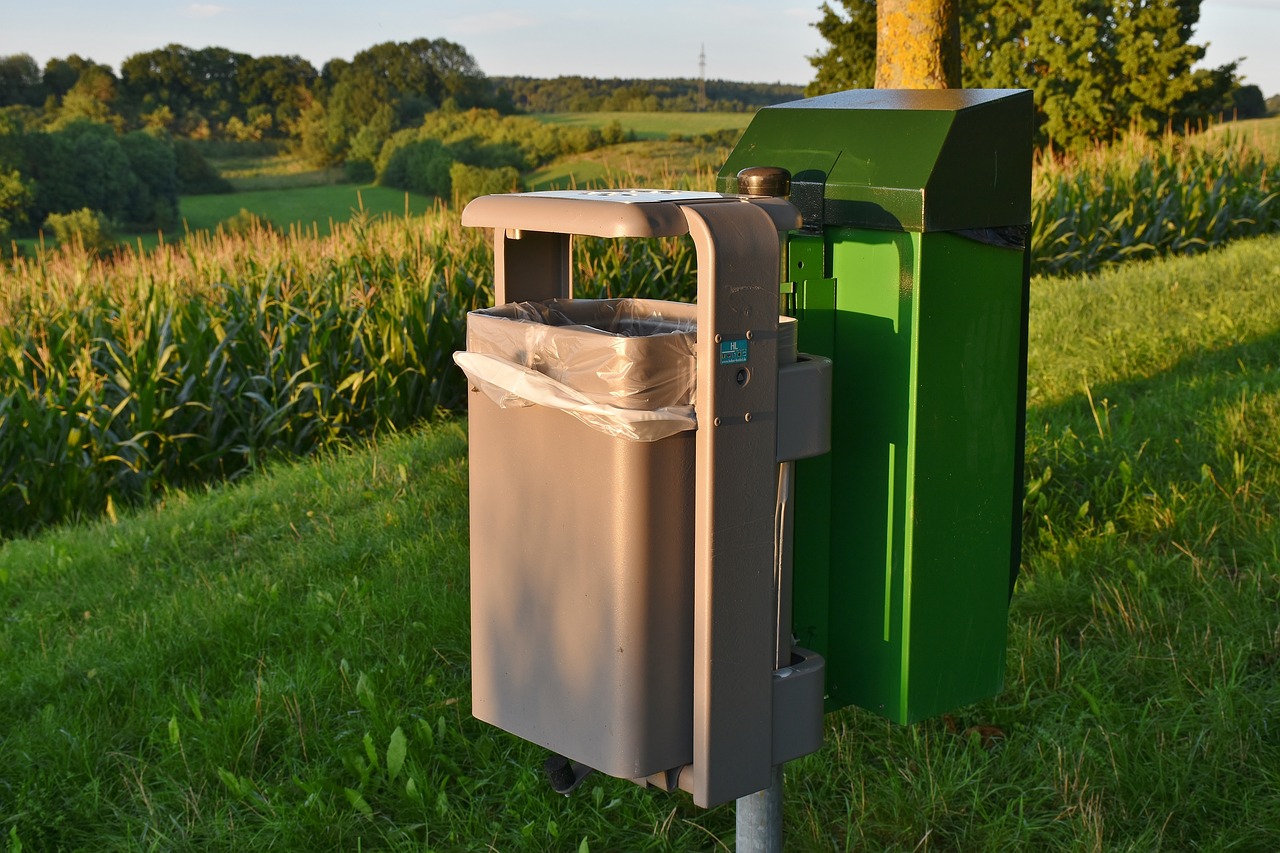The Role of Public Awareness in Recycling Success
In today's world, where environmental issues are at the forefront of global discussions, public awareness plays a pivotal role in the success of recycling efforts. Imagine a community where every individual is not only aware of the recycling processes but also actively participates in them. This scenario is not just a dream; it can be a reality through effective education and communication strategies. By fostering a culture of sustainability, we can significantly enhance recycling rates and promote eco-friendly practices. The journey begins with understanding how awareness impacts our actions and the environment.
Public awareness is more than just knowing that recycling exists; it encompasses a deep understanding of how recycling works, the benefits it provides, and the proper methods to recycle effectively. When individuals are informed, they are more likely to engage in recycling initiatives. For instance, consider the difference between merely knowing that you can recycle plastic and understanding the specific steps to clean, sort, and dispose of it correctly. This knowledge not only increases participation but also improves the quality of recycled materials, leading to more successful recycling outcomes.
Furthermore, the role of education cannot be overstated. Schools, community centers, and local governments must collaborate to provide comprehensive educational programs that explain the importance of recycling. These programs can include workshops, seminars, and informational campaigns that highlight the environmental impact of waste and the benefits of recycling. When communities are equipped with the right knowledge, they are empowered to make informed decisions that contribute to a healthier planet.
But education alone isn't enough. Community engagement is essential. By organizing local events such as clean-up days, recycling drives, and educational fairs, we can create a sense of responsibility and camaraderie among residents. When people come together with a shared goal, the collective effort can lead to remarkable outcomes. For example, communities that have implemented recycling competitions often see a significant increase in participation rates. It’s like turning recycling into a friendly game where everyone wins by contributing to a sustainable future.
Moreover, in this digital age, social media has emerged as a powerful tool for spreading awareness. Platforms like Facebook, Instagram, and Twitter can amplify recycling messages and encourage individuals to share their experiences. By creating engaging and shareable content, we can reach a broader audience and inspire more people to join the recycling movement. Collaborating with local influencers can further enhance the visibility of recycling campaigns, leveraging their reach to motivate others to adopt sustainable practices.
In conclusion, public awareness is the cornerstone of successful recycling efforts. It begins with education, flourishes through community engagement, and is amplified by effective communication strategies. By working together, we can build a society that values sustainability and actively participates in recycling. The more we educate, engage, and communicate, the closer we get to a cleaner, greener future.
- What is the most effective way to promote recycling in my community?
Organizing community events and workshops can significantly boost awareness and participation. - How can schools contribute to recycling efforts?
Implementing recycling programs and educating students about environmental responsibility can instill lifelong sustainable behaviors. - What role does social media play in recycling awareness?
Social media can spread recycling messages quickly and encourage community participation through shareable content.

The Importance of Education in Recycling
Education plays a crucial role in informing the public about recycling processes, benefits, and proper methods, ultimately leading to increased participation and better recycling outcomes within communities. Think about it: when people understand the *why* and *how* of recycling, they are far more likely to engage in it. Just like learning to ride a bike, the more you know about balancing and pedaling, the easier it becomes to ride smoothly. Similarly, knowledge about recycling empowers individuals to make informed decisions that positively impact the environment.
One of the key components of effective recycling education is the dissemination of accurate information. Many individuals may not realize that not all materials can be recycled, or that certain items require specific preparation before being placed in recycling bins. For instance, did you know that greasy pizza boxes often cannot be recycled? This kind of knowledge is vital. When communities are educated about these nuances, they are more likely to recycle correctly, which leads to better recycling rates and less contamination in the recycling stream.
Moreover, educational initiatives can take various forms, from workshops and community classes to online resources and school programs. For example, local governments can host events where residents can learn about the recycling process firsthand. These events can be engaging and interactive, making learning fun and memorable. Imagine a hands-on workshop where families can bring their recyclables and learn how to sort them properly. This not only educates but also strengthens community bonds.
Additionally, integrating recycling education into school curriculums can lay the foundation for environmentally responsible behaviors in young people. By teaching children about the importance of recycling from an early age, we instill values that promote lifelong sustainable practices. Schools can implement programs that encourage students to participate in recycling competitions or projects, further enhancing their understanding and commitment to recycling.
In summary, education is the bedrock of successful recycling initiatives. It enhances public understanding, encourages proper practices, and fosters a culture of sustainability. When communities are equipped with the right knowledge, they can take meaningful actions that contribute to a healthier planet. As we continue to push for higher recycling rates, it's essential to prioritize educational efforts that empower individuals to make a difference.
Frequently Asked Questions
- Why is recycling education important? Recycling education helps individuals understand the processes and benefits of recycling, leading to increased participation and better outcomes.
- What are some effective ways to educate the public about recycling? Workshops, community events, school programs, and online resources are all effective methods for educating the public.
- How can schools contribute to recycling education? Schools can implement recycling programs, competitions, and integrate environmental education into their curriculums.

Community Engagement Strategies
When it comes to recycling, the phrase "it takes a village" couldn't be more accurate. Community engagement strategies are vital for elevating recycling participation and fostering a culture of sustainability. By actively involving residents in recycling initiatives, we create a sense of ownership and responsibility that can lead to impressive results. Think of it like a neighborhood potluck; when everyone brings a dish, the meal becomes a feast. Similarly, when communities come together to support recycling efforts, the impact is magnified.
One effective way to boost engagement is through organizing local events that focus on recycling education and participation. These can range from clean-up days, where residents gather to clean their neighborhoods and learn about proper waste disposal, to recycling fairs that showcase innovative recycling methods and local resources. Imagine a vibrant community gathering filled with fun activities, informative booths, and the buzz of people eager to learn how they can make a difference. Not only does this create a fun atmosphere, but it also fosters connections among residents, encouraging them to work together toward a common goal.
Another powerful strategy is to leverage the capabilities of social media platforms. In today’s digital age, social media serves as a megaphone for spreading awareness and rallying support. Community leaders can create dedicated pages or groups that focus on recycling initiatives, sharing tips, success stories, and upcoming events. This not only keeps the conversation going but also encourages individuals to share their own experiences and ideas. For instance, a local recycling group might post a challenge encouraging members to reduce their waste for a month, with participants sharing their progress online. This creates a ripple effect, inspiring others to join in!
Moreover, collaborating with local influencers can significantly amplify these efforts. Influencers have the unique ability to reach a wide audience and can help spread the message of recycling to demographics that might otherwise be disengaged. By partnering with these community figures, recycling campaigns can gain visibility and credibility, making it more likely that people will participate. Imagine a popular local figure sharing their recycling journey on social media; it could inspire countless others to follow suit!
Additionally, schools can play a pivotal role in community engagement strategies. By implementing recycling programs within educational institutions, we can instill values of environmental responsibility in young minds. Schools can organize competitions, like "Recycling Olympics," where students earn points for their classes based on the amount of recyclables collected. This not only promotes recycling but also fosters teamwork and pride among students. Plus, when kids take these lessons home, they can influence their families, creating a ripple effect that extends beyond school walls.
Ultimately, the key to successful community engagement in recycling lies in creating a welcoming and informative environment. When residents feel informed, supported, and connected, they are more likely to participate actively in recycling initiatives. It’s about building a community that sees recycling not just as a chore, but as a fulfilling and collective responsibility. By employing these strategies, we can transform our communities into champions of sustainability, making a lasting impact on our environment.
- How can I get involved in local recycling programs? Many communities have local organizations or government initiatives that you can join. Check your city’s website for information on upcoming events.
- What types of materials can be recycled in my area? Recycling guidelines vary by location, so it's best to consult your local waste management authority for specific details.
- How can I encourage my friends and family to recycle more? Share your knowledge about recycling benefits and practices, and invite them to participate in community events with you.
- Are there any rewards for participating in community recycling efforts? Some communities offer incentives, such as discounts or recognition programs, for active participants in recycling initiatives.

Utilizing Social Media for Awareness
In today’s digital age, social media has transformed into a powerful tool for spreading awareness about various issues, including recycling. Imagine this: a single post on Facebook or Instagram can reach thousands, if not millions, of people within minutes. This incredible reach can be harnessed to educate the public and drive participation in recycling initiatives. But how exactly can we utilize these platforms effectively?
First and foremost, creating engaging content is key. Posts that are visually appealing and informative tend to attract more attention. For instance, using eye-catching graphics or videos that demonstrate the recycling process can captivate your audience. Think of it as telling a story; the more engaging the narrative, the more likely people are to share it. Content that shows the impact of recycling—like before-and-after photos of clean-up efforts—can evoke emotions and inspire action.
Moreover, social media campaigns can encourage community participation in local recycling programs. By using hashtags like #RecycleRight or #WasteNotWantNot, individuals can share their recycling efforts and challenges, creating a sense of community. This not only raises awareness but also fosters a supportive environment where people can learn from each other. You might even consider hosting challenges or contests, where participants can post photos of their recycling efforts for a chance to win eco-friendly prizes. This adds an element of fun and competition, making recycling more appealing.
Additionally, partnering with local influencers can significantly amplify your message. Influencers already have established trust and rapport with their followers, and their endorsement can lend credibility to your recycling initiatives. By collaborating with them, you can reach a broader audience and inspire more individuals to adopt sustainable practices. It’s like having a friend recommend a great restaurant; you’re more likely to try it out because someone you trust has given it a thumbs up.
Finally, don't underestimate the power of community engagement through social media. Hosting live Q&A sessions, webinars, or virtual workshops can provide valuable information while allowing people to ask questions and express concerns. This two-way communication fosters a sense of ownership and accountability within the community. When people feel involved, they are more likely to participate actively in recycling efforts.
In conclusion, utilizing social media for recycling awareness is not just about posting information; it’s about creating a movement. By crafting engaging content, leveraging influencer partnerships, and fostering community interaction, we can turn the tide on recycling participation. Remember, every small effort counts, and with the right strategies, we can inspire a wave of change that leads to a more sustainable future.
- How can I get involved in local recycling initiatives? Check your community's website for upcoming events or programs focused on recycling.
- What types of materials can I recycle? Most communities accept plastics, paper, glass, and metals, but always check local guidelines.
- How can social media help in recycling efforts? It raises awareness, encourages participation, and fosters community engagement.
- What are some effective ways to share recycling tips on social media? Use visuals, share personal stories, and create engaging challenges.

Creating Shareable Content
In today's digital age, creating shareable content is essential for amplifying recycling messages and engaging a broader audience. Think of it as crafting a catchy tune that gets stuck in people's heads; if your content resonates, it will be shared far and wide. The key to this lies in understanding what makes content appealing and relevant to your audience. Engaging visuals, relatable stories, and actionable tips can transform a mundane recycling message into a viral sensation.
One effective strategy is to incorporate infographics that visualize important recycling statistics and processes. For instance, a well-designed infographic can illustrate the recycling journey of a plastic bottle, from disposal to its rebirth as a new product. This not only educates but also captivates the audience's attention, making them more likely to share it on social media platforms.
Another tactic is to create short videos that highlight the benefits of recycling. Videos can be powerful storytelling tools that evoke emotions and inspire action. For example, a quick clip showcasing a community coming together to clean up a local park can motivate viewers to participate in similar initiatives. When content is entertaining or emotionally resonant, it encourages viewers to hit that share button without a second thought.
Moreover, consider using challenges or contests as a way to engage your audience. For instance, you could launch a "Recycling Challenge" on social media, encouraging people to showcase their best recycling practices. Participants can post pictures or videos of their efforts using a specific hashtag, creating a sense of community and friendly competition. This not only spreads awareness but also fosters a collective responsibility toward recycling.
Finally, it's crucial to ensure that your content is easily shareable. This means incorporating social media buttons on your website or blog, making it simple for readers to share your posts with their friends and followers. Additionally, crafting compelling headlines and using engaging visuals can significantly increase the likelihood of your content being shared. Remember, the more accessible and appealing your content is, the more it will resonate with your audience, leading to greater participation in recycling initiatives.
In summary, creating shareable content is about tapping into the emotions and interests of your audience. By using engaging visuals, relatable stories, contests, and ensuring easy sharing, you can amplify your recycling message and inspire more individuals to take action. So, get creative and start crafting content that not only informs but also excites and motivates!
- Why is shareable content important for recycling?
Shareable content helps spread awareness and encourages community engagement, making recycling initiatives more effective. - What types of content are most shareable?
Infographics, videos, and interactive challenges tend to be highly shareable as they engage the audience and evoke emotions. - How can I encourage my audience to share my content?
Make it easy to share by including social media buttons, create compelling visuals, and craft interesting headlines that capture attention.

Influencer Partnerships
In today's digital age, influencer partnerships have emerged as a dynamic and effective strategy for enhancing recycling initiatives. Imagine having a trusted voice in your community—someone who can effortlessly sway opinions and inspire action. That's precisely what influencers bring to the table! By collaborating with local influencers, recycling campaigns can gain a significant boost in visibility and appeal, reaching audiences that traditional methods might miss.
Influencers, whether they are local bloggers, social media personalities, or community leaders, have the power to connect with their followers on a personal level. Their endorsement can make recycling not just a responsibility but a trend. When influencers share their own recycling practices, they create a ripple effect, encouraging their audience to participate actively. For instance, if an influencer posts a video of themselves sorting recyclables or participating in a community clean-up, it not only educates their followers but also motivates them to take similar actions. This is where the magic happens—when followers see their role models engaging in sustainable practices, they are more likely to emulate those behaviors.
Moreover, influencer partnerships can help tailor messaging to resonate with specific demographics. Different influencers appeal to different audiences, and their unique styles can be leveraged to craft messages that are relatable and engaging. For example, a fitness influencer might focus on the environmental benefits of recycling sports equipment, while a fashion influencer could highlight sustainable fashion choices by promoting thrift shopping. By aligning with the right influencers, recycling campaigns can ensure that their messages hit home, making sustainability feel accessible and relevant to various groups.
To maximize the impact of these partnerships, it's essential to establish clear objectives and metrics for success. This could include tracking engagement rates on social media posts, measuring participation in recycling programs, or even assessing changes in community attitudes toward recycling. By analyzing these metrics, organizations can refine their strategies, ensuring that influencer collaborations yield the best possible outcomes.
In summary, influencer partnerships represent a powerful avenue for enhancing public awareness and participation in recycling efforts. By harnessing the influence of trusted community figures, recycling campaigns can inspire action, foster a sense of community responsibility, and ultimately contribute to a more sustainable future. So, if you're looking to amplify your recycling message, consider reaching out to local influencers—after all, a little influence can go a long way!
- What are influencer partnerships? Influencer partnerships involve collaborating with individuals who have a significant following on social media or in the community to promote a cause or initiative.
- How can influencers help recycling efforts? Influencers can raise awareness, inspire their followers to participate in recycling programs, and tailor messages to resonate with specific audiences.
- What metrics should be tracked for influencer campaigns? Engagement rates, participation levels in recycling programs, and changes in community attitudes are key metrics to assess the effectiveness of influencer collaborations.

School Programs and Initiatives
This article explores how public awareness impacts recycling efforts, highlighting the importance of education, community involvement, and effective communication strategies to enhance recycling rates and foster sustainable practices.
Education plays a crucial role in informing the public about recycling processes, benefits, and proper methods, ultimately leading to increased participation and better recycling outcomes within communities.
Engaging communities through events, workshops, and local initiatives can significantly boost recycling participation, fostering a sense of responsibility and collective effort toward sustainable waste management.
Social media platforms serve as powerful tools for spreading awareness about recycling initiatives, encouraging individuals to share information and participate in local recycling programs.
Developing engaging and informative content that is easy to share can help amplify recycling messages and reach a broader audience, increasing community involvement.
Collaborating with local influencers can enhance the visibility of recycling campaigns, leveraging their reach to inspire more individuals to adopt sustainable practices.
Implementing recycling programs in schools is like planting seeds for the future; it educates young people about environmental responsibility and instills values that promote lifelong sustainable behaviors. Schools are not just places for academic learning; they are also vital environments for nurturing socially responsible citizens. By introducing recycling initiatives, schools can create a culture of sustainability that students carry into their homes and communities.
For instance, many schools have adopted hands-on projects that allow students to actively participate in recycling. These projects can range from simple classroom activities to larger community clean-up events. Engaging students in such activities not only teaches them the importance of recycling but also empowers them to take action. When students feel involved, they are more likely to share their knowledge with family and friends, amplifying the recycling message.
In addition to practical projects, schools can also integrate recycling education into their curricula. Subjects like science and social studies can incorporate lessons on waste management, the environmental impact of littering, and the benefits of recycling. By making these topics part of their academic journey, students learn to appreciate the significance of recycling in a broader context.
Furthermore, schools can establish recycling clubs where students can lead initiatives, organize events, and create awareness campaigns. Such clubs foster leadership skills and a sense of community among students, reinforcing the idea that collective efforts can lead to significant environmental changes.
To illustrate the impact of school recycling programs, consider the following table that outlines some successful initiatives:
| School Name | Program Type | Impact |
|---|---|---|
| Green Valley High | Recycling Club | Increased recycling rate by 30% in one year |
| Sunnydale Elementary | Classroom Projects | Educated 500+ students on recycling benefits |
| Riverbank Academy | Community Clean-Up | Collected 200 bags of recyclable materials |
Overall, school programs and initiatives not only educate students but also engage them in meaningful ways, fostering a generation that values sustainability. The ripple effect of these programs can lead to a more environmentally conscious society, making schools a cornerstone in the fight against waste.
Clear and concise communication about recycling guidelines, schedules, and benefits is essential for motivating individuals to participate and understand the impact of their efforts on the environment.
Utilizing visuals and informative signage can help simplify recycling processes and encourage proper sorting of materials, making it easier for the public to engage effectively.
Establishing feedback channels allows communities to voice their concerns and suggestions, fostering a sense of ownership and continuous improvement in recycling efforts.
- What are the benefits of recycling? Recycling conserves natural resources, reduces waste in landfills, and lowers greenhouse gas emissions.
- How can I start a recycling program in my school? Begin by gathering interested students and teachers, assess current waste practices, and develop a plan that includes education and community involvement.
- What materials can typically be recycled? Common recyclable materials include paper, cardboard, glass, metals, and certain plastics. Always check local guidelines!

Effective Communication Techniques
When it comes to recycling, effective communication is the secret sauce that can turn a good initiative into a great one. Imagine trying to bake a cake without following a recipe—confusing, right? Similarly, without clear communication about recycling guidelines, many individuals may feel lost or unsure about how to properly recycle. This is why it’s crucial to provide clear and concise information regarding what can and cannot be recycled, as well as the benefits of participating in these programs. By simplifying the message, we can make it much easier for people to understand their role in the recycling process.
One of the most impactful ways to communicate recycling information is through visual campaigns. Think about it: a picture is worth a thousand words! Utilizing eye-catching graphics and informative signage can help demystify the recycling process, making it more approachable for everyone. For instance, a well-designed poster that illustrates how to sort recyclables can serve as a quick reference guide for individuals at home, in schools, or even in public spaces. This kind of visual aid not only captures attention but also reinforces the message every time someone sees it.
Additionally, creating a feedback loop is essential for improving community engagement in recycling efforts. Establishing channels where community members can voice their concerns or suggestions fosters a sense of ownership and responsibility. When people feel like their opinions matter, they are more likely to participate actively. Think of it as a conversation rather than a one-way street. By listening to the community, organizations can adapt their strategies and communication techniques, ensuring that they resonate with the audience.
Moreover, it's essential to highlight the benefits of recycling through effective communication. Many individuals may not fully grasp how their actions impact the environment. By sharing statistics, success stories, and tangible outcomes of recycling efforts, we can motivate more people to get involved. For example, sharing data on how much waste has been diverted from landfills or how recycling has positively impacted local ecosystems can inspire individuals to take action. A simple table showcasing the benefits might look like this:
| Benefit | Impact |
|---|---|
| Reduced Landfill Waste | Less strain on landfills, prolonging their lifespan |
| Conservation of Resources | Less extraction of raw materials, preserving natural habitats |
| Energy Savings | Recycling often uses less energy compared to producing new items |
| Community Engagement | Fosters a sense of responsibility and collective action |
In conclusion, effective communication techniques are vital for enhancing recycling participation. By utilizing visuals, creating feedback channels, and emphasizing the benefits of recycling, we can inspire individuals to take action and contribute to a more sustainable future. It’s all about making the information accessible and engaging, so everyone feels empowered to play their part in protecting our planet.
- What materials can be recycled? Most communities accept paper, cardboard, glass, metal, and certain plastics. Always check local guidelines!
- How can I get involved in local recycling efforts? Participate in community clean-up events, attend workshops, or volunteer with local environmental organizations.
- What should I do if I have questions about recycling? Reach out to your local waste management authority; they can provide guidance and resources.
- Are there any incentives for recycling? Some communities offer rewards programs or discounts for active recyclers—check with local initiatives!

Visual Campaigns and Signage
In today's fast-paced world, where information is bombarded at us from all angles, stand out as essential tools for promoting recycling efforts. Imagine walking through your neighborhood and being greeted by vibrant posters, eye-catching banners, and informative signs that not only grab your attention but also educate you about recycling. These visual elements are not just decorative; they serve a crucial purpose in simplifying complex recycling processes and encouraging community participation.
Effective signage can transform a mundane task into an engaging experience. For instance, clear and colorful graphics that illustrate what can and cannot be recycled can significantly reduce contamination in recycling bins. When people see a brightly colored sign with a simple image of a plastic bottle alongside a big red "X" over a pizza box, they instantly understand the do's and don'ts of recycling. This kind of visual clarity is vital in ensuring that people feel confident in their recycling efforts.
Moreover, incorporating local art and community themes into recycling signage can foster a sense of ownership and pride among residents. When community members see familiar faces or local landmarks represented in recycling campaigns, it resonates with them on a personal level. This connection can motivate individuals to participate actively in recycling initiatives, as they feel they are contributing to a cause that reflects their community's identity.
To maximize the impact of visual campaigns, it’s essential to consider the placement and accessibility of signage. Signs should be strategically positioned in high-traffic areas, such as parks, schools, and shopping centers, where they can reach a broad audience. Additionally, using multilingual signs can ensure inclusivity, allowing non-native speakers to understand and engage with recycling initiatives effectively. By catering to the diverse demographics of a community, these campaigns can enhance participation rates and foster a culture of sustainability.
Another innovative approach is to utilize technology in visual campaigns. For example, integrating QR codes into signage can provide passersby with instant access to detailed recycling information, local programs, and upcoming events. This tech-savvy method not only engages a younger audience but also makes recycling information readily available at the fingertips of everyone. It’s like having a personal recycling assistant right in your pocket!
In conclusion, the power of in promoting recycling cannot be underestimated. By combining clear messaging, local culture, strategic placement, and technology, communities can create an engaging and informative environment that encourages individuals to take an active role in recycling. The more we can simplify and beautify the recycling process through effective visuals, the more likely we are to see a significant increase in community participation and, ultimately, a healthier planet.
- What types of visuals are most effective for recycling campaigns?
Bright, colorful graphics that clearly illustrate recycling rules tend to be the most effective. Using local imagery can also enhance community connection. - How can technology enhance recycling awareness?
Integrating QR codes into signage allows people to access detailed information about recycling programs and guidelines instantly. - Why is community involvement important in recycling efforts?
Community involvement fosters a sense of ownership and responsibility, which can lead to higher participation rates and more effective recycling practices.

Feedback and Improvement Mechanisms
Feedback and improvement mechanisms are essential components of a successful recycling program. They act as the pulse of the community's recycling efforts, allowing individuals to express their thoughts, concerns, and suggestions regarding the current system. When communities feel that their voices are heard, they are more likely to engage actively in recycling initiatives. Imagine a scenario where a community implements a new recycling program, but the residents are unsure about the guidelines. If there are no channels for feedback, confusion will reign, and participation will dwindle. However, by establishing clear feedback mechanisms, such as suggestion boxes, online surveys, or community forums, residents can share their experiences and insights.
Moreover, these feedback systems can lead to continuous improvement. For instance, if a significant number of residents express confusion about what items are recyclable, the program can adapt by providing clearer communication or even re-evaluating what materials are accepted. This adaptability not only enhances the program's effectiveness but also fosters a sense of ownership within the community. Residents start to see recycling not just as a chore but as a shared responsibility that they can influence.
To further illustrate the impact of feedback mechanisms, consider the following table that highlights key benefits:
| Benefit | Description |
|---|---|
| Increased Engagement | When residents can voice their opinions, they feel more invested in the recycling process. |
| Enhanced Communication | Feedback helps identify gaps in communication, allowing for more effective messaging about recycling guidelines. |
| Adaptability | Programs can quickly adapt to community needs and preferences, ensuring relevance and effectiveness. |
| Community Trust | Transparent feedback channels build trust between the community and program administrators. |
In addition to traditional feedback channels, leveraging technology can significantly enhance the feedback process. Mobile apps and social media platforms can be utilized to create real-time communication channels. For example, a community could develop an app where residents can report issues such as overflowing recycling bins or request information about recycling events. This immediacy not only makes it easier for residents to participate but also allows program administrators to address concerns promptly.
Ultimately, incorporating feedback mechanisms into recycling programs is not just about collecting opinions; it’s about creating a dynamic relationship between the community and its recycling initiatives. By actively listening to residents and implementing their suggestions, communities can foster a culture of sustainability where recycling becomes second nature. This collaborative approach not only improves the recycling rates but also cultivates a shared commitment to environmental stewardship.
- What types of feedback mechanisms can be implemented? Common mechanisms include suggestion boxes, online surveys, community meetings, and social media engagement.
- How can feedback improve recycling programs? Feedback can identify areas of confusion, enhance communication, and adapt programs to better meet community needs.
- Why is community trust important in recycling efforts? Trust encourages participation and accountability, leading to higher recycling rates and a stronger commitment to sustainability.
- Can technology enhance feedback processes? Yes, mobile apps and social media can facilitate real-time communication and make it easier for residents to share their thoughts.
Frequently Asked Questions
- Why is public awareness crucial for recycling success?
Public awareness is vital because it directly influences participation rates in recycling programs. When people understand the benefits of recycling and how to do it correctly, they are more likely to engage in sustainable practices. Education and communication empower individuals to make informed choices, ultimately leading to better recycling outcomes.
- How can education improve recycling rates?
Education informs the public about what can and cannot be recycled, the environmental benefits of recycling, and the proper methods for sorting materials. When communities are educated about these aspects, they tend to recycle more effectively, reducing contamination and increasing the overall quality of recyclable materials.
- What role do community engagement strategies play?
Community engagement strategies, such as workshops, local events, and clean-up drives, foster a sense of responsibility and teamwork among residents. By involving the community in hands-on activities, people feel a greater connection to the cause, which can significantly boost recycling participation and awareness.
- How can social media enhance recycling awareness?
Social media platforms are powerful tools for spreading awareness about recycling initiatives. They enable individuals and organizations to share informative content, engage in discussions, and promote local recycling programs. By creating shareable content, communities can reach a wider audience and inspire more people to participate.
- What are some effective communication techniques for recycling?
Effective communication techniques include clear messaging about recycling guidelines, schedules, and benefits. Utilizing visual campaigns and informative signage can simplify the recycling process and motivate individuals to participate. Consistent and concise communication helps ensure that everyone understands their role in recycling efforts.
- Why are school programs important for recycling?
School programs play a crucial role in educating young people about environmental responsibility. By implementing recycling initiatives in schools, children learn the importance of sustainable practices early on, instilling values that promote lifelong commitment to recycling and environmental stewardship.
- How can feedback mechanisms improve recycling efforts?
Establishing feedback channels allows community members to voice their concerns and suggestions regarding recycling programs. This fosters a sense of ownership and encourages continuous improvement. When people feel heard, they are more likely to engage positively with recycling initiatives.



















